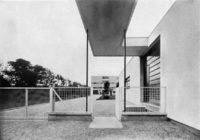The Apple of Our Eye

Photo © Michel Arnaud
Weeks before his passing, Steve Jobs' contributions to architecture and design were the subject of an editorial by RECORD editor in chief Cathleen McGuigan. What follows is a reflection on Jobs' impact on the architecture profession and the world at large.
I’m writing this letter on an iMac. I just got off a call on my iPhone 4. I still have a beloved old MacBook, but I’m cheating on it with an iPad 2.
This is not a paid testimonial. Like a lot of people connected to the design world, I’m merely a devoted member of the cult of Apple. The sad news at summer’s end that Steve Jobs was resigning as the company’s CEO felt like a watershed moment for our culture. It got me thinking, too, about Jobs’s complicated relationship to architecture.
Not long ago, I visited an architect’s studio, a pristine white loft with long rows of work tables topped by a battalion of gorgeous iMacs. What other brand of computer could such an office possibly employ? The firm is known for serene, crisply detailed minimalist buildings; naturally, the principal architect is a devotee of Apple. He’s someone who would deeply appreciate products so beautifully designed that they express exactly what they do, nothing more. The idea behind Apple isn’t that form follows function, but that each object is the ultimate integration of both. Or as Yeats might well have put it, had he beheld an iPod, “How can we know the dancer from the dance?”
Yet there is, as you know, a flaw in that seeming perfection, at least for the field of architecture. For years, Macs had to be adapted to run some of the top software architects use. As much as practitioners might like the beauty and artful operation of Apple’s computers, many have opted to equip their offices with PCs. (The iPad, on the other hand, is turning up more and more at client meetings and building sites.)
We can’t forget that Jobs has been a notable architectural patron. He commissioned Peter Bohlin, the 2010 AIA Gold Medalist, to create Apple’s retail stores, including the stunning iconic glass cube for the New York flagship on Fifth Avenue. Jobs has been fascinated by design at least since his days as a college dropout. In a commencement address at Stanford in 2005, Jobs, who grew up as a working-class kid, talked about the influence of a calligraphy class he’d audited at Reed College. He learned about typeface and later would carefully consider the fonts for the first Mac. He dreamed of encasing Apple I in blonde koa wood. When he started the company NeXT, he got the celebrated graphic designer Paul Rand to create the logo. At Apple, he has regularly haunted the studio of his chief designer, Jonathan Ive.
But some of Jobs’s decisions about architecture have been controversial. He hired Bohlin to design a 6,000-square-foot house for his family—but wanted to build it on the site of his 14-bedroom onetime bachelor pad, a 1926 mansion in Woodside, California, by architect George Washington Smith, the godfather of Spanish Colonial Revival. Preservationists were outraged that he was eager to tear it down. After a long legal tug-of-war, during which Jobs let the house badly deteriorate, he was allowed to demolish it last February.
And his latest architectural adventure, the design of a gigantic new doughnut-shaped headquarters for Apple, is already drawing mixed reviews. At the Cupertino, California, city council meeting where he unveiled the scheme last June, the ferociously secretive Jobs didn’t even mention the name of the architect—though the Foster + Partners logo was on the drawings. In the Los Angeles Times, critic Christopher Hawthorne called the 2.8 million-square-foot building for 12,000 Apple employees “doggedly old-fashioned,” akin to the 20th-century corporate office parks that turned away from urban vitality.
I can imagine the conversations between Jobs and Norman Foster, the Lord of the Ring. Steve would love hearing about Foster’s early mentor, the genius innovator Buckminster Fuller, who was a hero, too, of Stewart Brand, the guru behind the 1960s Whole Earth Catalog. In that same Stanford speech, Jobs cited Brand’s “bible.” It was, he said, “sort of like Google in paperback form, 35 years before Google came along: It was idealistic, and overflowing with neat tools and great notions.”
Neat tools, great notions—those simple words could be Jobs’s legacy. While Apple fanatics everywhere fret about the company’s future without him, architects especially can appreciate the Jobs ethos: How a design looks is inseparable from how it works.





